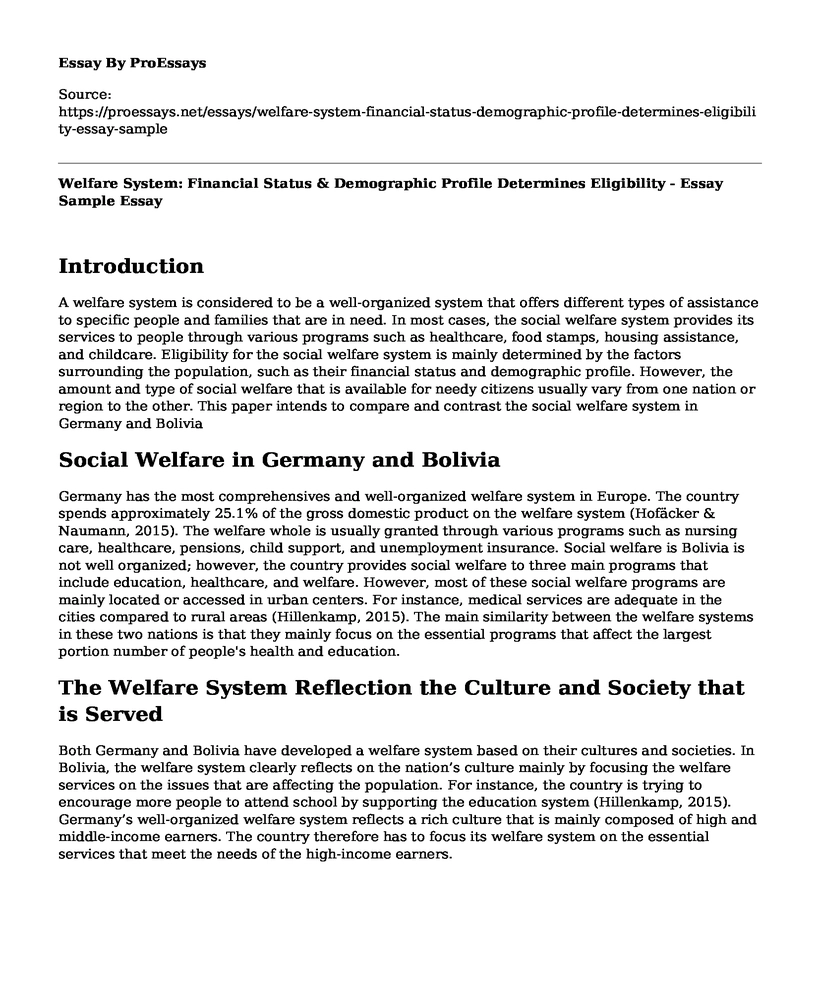Introduction
A welfare system is considered to be a well-organized system that offers different types of assistance to specific people and families that are in need. In most cases, the social welfare system provides its services to people through various programs such as healthcare, food stamps, housing assistance, and childcare. Eligibility for the social welfare system is mainly determined by the factors surrounding the population, such as their financial status and demographic profile. However, the amount and type of social welfare that is available for needy citizens usually vary from one nation or region to the other. This paper intends to compare and contrast the social welfare system in Germany and Bolivia
Social Welfare in Germany and Bolivia
Germany has the most comprehensives and well-organized welfare system in Europe. The country spends approximately 25.1% of the gross domestic product on the welfare system (Hofäcker & Naumann, 2015). The welfare whole is usually granted through various programs such as nursing care, healthcare, pensions, child support, and unemployment insurance. Social welfare is Bolivia is not well organized; however, the country provides social welfare to three main programs that include education, healthcare, and welfare. However, most of these social welfare programs are mainly located or accessed in urban centers. For instance, medical services are adequate in the cities compared to rural areas (Hillenkamp, 2015). The main similarity between the welfare systems in these two nations is that they mainly focus on the essential programs that affect the largest portion number of people's health and education.
The Welfare System Reflection the Culture and Society that is Served
Both Germany and Bolivia have developed a welfare system based on their cultures and societies. In Bolivia, the welfare system clearly reflects on the nation’s culture mainly by focusing the welfare services on the issues that are affecting the population. For instance, the country is trying to encourage more people to attend school by supporting the education system (Hillenkamp, 2015). Germany’s well-organized welfare system reflects a rich culture that is mainly composed of high and middle-income earners. The country therefore has to focus its welfare system on the essential services that meet the needs of the high-income earners.
Conclusion
A welfare system is an organized system that intends to fulfill the needs of the population. Welfare serves however, usually vary from one country to the other depending on the needs of the population. The main similarity between Bolivian and Germany's welfare system is that they both focus on the main issues affecting the population. The main difference between the two countries' welfare systems is that they are managed or organized differently.
References
Hofäcker, D., & Naumann, E. (2015). The emerging trend of work beyond retirement age in Germany. Zeitschrift für Gerontologie und Geriatrie, 48(5), 473-479. https://link.springer.com/article/10.1007/s00391-014-0669-y
Hillenkamp, I. (2015). Solidarity economy for development and women's emancipation: Lessons from Bolivia. Development and Change, 46(5), 1133-1158. https://onlinelibrary.wiley.com/doi/abs/10.1111/dech.12193
Cite this page
Welfare System: Financial Status & Demographic Profile Determines Eligibility - Essay Sample. (2023, Aug 14). Retrieved from https://proessays.net/essays/welfare-system-financial-status-demographic-profile-determines-eligibility-essay-sample
If you are the original author of this essay and no longer wish to have it published on the ProEssays website, please click below to request its removal:
- Communicating Effectively Assessment Annotated Bibliography
- Human Papillomavirus (HPV) and Cervical Cancer Paper Example
- Paper Example on Disorders of Ventilation and Gas Exchange
- Essay Sample on Racial Ethnic and Identity
- Essay Sample on Issues Surrounding Indigenous Groups or Ethnic Minorities
- Practical Nursing Essay Example
- Comparing Gender Construction and Norms in US and UK - Essay Sample







